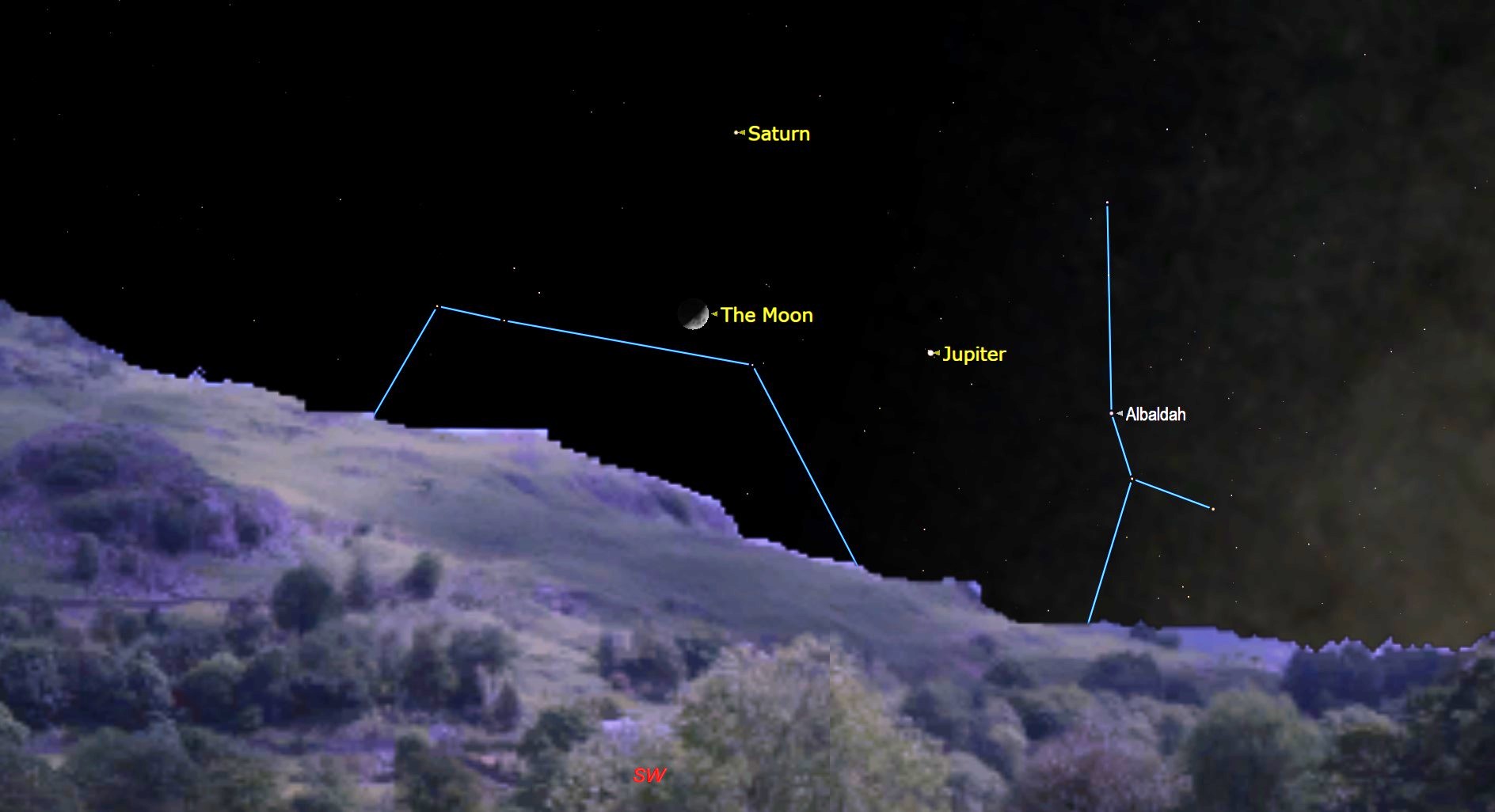
Skywatchers will be treated to an eye-catching gathering in the south-southwest sky about an hour after sunset on Thursday (Oct. 22) — a large triangle formed by the moon and two bright "superior" planets.
A superior planet is one that is located in an orbit around the sun that is beyond that of Earth. The planets in question are Jupiter and Saturn, which have attracted the attention of skywatchers all through the summer and early fall.
Of course, these close alignments are merely an illusion of perspective. Our moon is much closer in space to us than is either Jupiter or Saturn. As it orbits Earth, the moon moves in an easterly direction across the sky at roughly its own apparent diameter (0.5 degrees) each hour, or approximately 12 degrees per day. (Your clenched fist held at arm's length covers about 10 degrees of sky.)
Currently, Jupiter and Saturn are located in the zodiacal constellation of Sagittarius, positioned above and to the left of the popular "Teapot" asterism. The two planets are now separated by about 6 degrees, but they'll be getting a lot closer to each other in the days and weeks to come as we get closer to their so-called "Great Conjunction" in late December.
Related: Best night sky events of October 2020 (stargazing maps)
Jupiter and its retinue
Thursday night's rendezvous between the moon, Jupiter and Saturn will be an eye-catching sight, which probably will attract the attention even of those who don't normally pay much attention to the night sky. Beginning about an hour after sunset, cast your eyes about a quarter of the way up from the south-southwest horizon. There you will find a wide crescent moon hovering about 4 degrees to the lower left of brilliant Jupiter.
And if you use a telescope or even steadily held binoculars, you can also catch a view of all four famous Galilean satellites, which were first viewed in 1610 by Galileo Galilei using his crude homemade telescope. One satellite stands by itself on one side of Jupiter. That will be Callisto. Meanwhile, on the opposite side will be the three other Galilean moons: Moving out from Jupiter will be Europa, Io and Ganymede.
Get the Space.com Newsletter
Breaking space news, the latest updates on rocket launches, skywatching events and more!
Saturn: 'Lord of the rings'
The moon will also team up with the ringed wonder of the solar system, Saturn. Just look about 4.5 degrees to the moon's upper left and you'll see a bright yellowish-white "star" shining with a steady, sedate glow. That will be Saturn.
When a telescope or large binoculars with at least 20-power magnification are trained on Saturn, one immediately sees that here is a planet that stands out from the others, thanks to its magnificent system of rings. Like the four big moons of Jupiter, the rings were first seen by Galileo, though because he was using a crude telescope, he could not make out what they actually were.
As seen through Galileo's telescope, Saturn seemed to have an oval shape. He at first thought there were two motionless moons on either side of the planet. But when Saturn turned its rings edgewise toward Earth, the "moons" completely vanished and Galileo was faced with a mystery he never solved.
Currently the rings are readily seen even in small instruments because their north face is tilted 21 degrees to our line of sight. They are composed of countless billions of icy particles.
All three worlds — the moon, Jupiter and Saturn — will be in good view until about 9 p.m. local time. But as they get progressively lower in the southwest sky, they might become obscured by buildings or trees, so it's probably best to catch them during the earlier part of the night when the trio appears higher in the sky. They will set around 11 p.m.
Joe Rao serves as an instructor and guest lecturer at New York's Hayden Planetarium. He writes about astronomy for Natural History magazine, the Farmers' Almanac and other publications. Follow us on Twitter @Spacedotcom and on Facebook.
Join our Space Forums to keep talking space on the latest missions, night sky and more! And if you have a news tip, correction or comment, let us know at: community@space.com.

Joe Rao is Space.com's skywatching columnist, as well as a veteran meteorologist and eclipse chaser who also serves as an instructor and guest lecturer at New York's Hayden Planetarium. He writes about astronomy for Natural History magazine, Sky & Telescope and other publications. Joe is an 8-time Emmy-nominated meteorologist who served the Putnam Valley region of New York for over 21 years. You can find him on Twitter and YouTube tracking lunar and solar eclipses, meteor showers and more. To find out Joe's latest project, visit him on Twitter.









